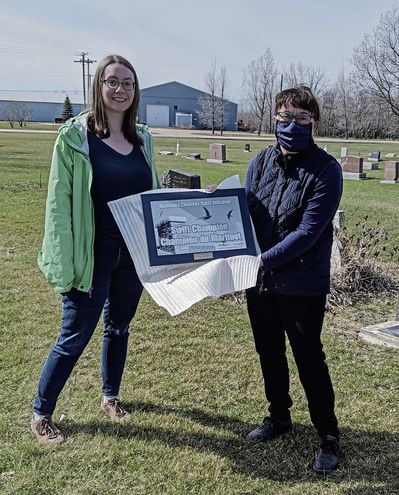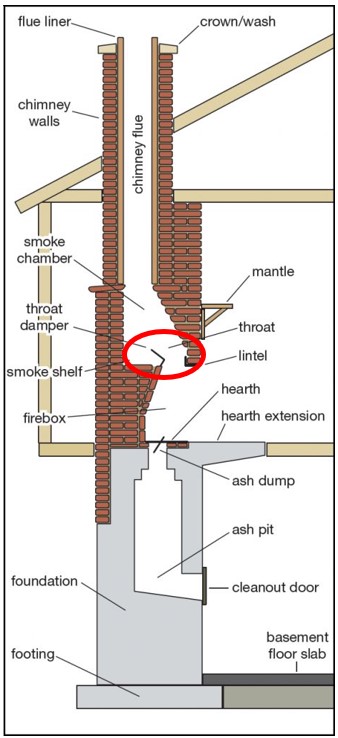
Over in St Adolphe Barb, Rob and Ryan have been battling the mosquitoes in order to monitor the swifts. Rob and Ryan made some cosmetic repairs to update the artificial Chimney Swift tower (not in use by the swifts this year) – a big thank you to both. The two Club Amical chimneys occupied by swifts have young that hatched July 9th and both show high (3 times/ hour) feeding rates. The nestlings at the St Adolphe Church hatched July 4th, and also have high feeding rates (up to 5 times/ hour). The chimney in use on Main St in St Adolphe is providing a bit of mystery this year, as Barb mentioned, “Some days it’s 80 minutes between visits and Friday it was one nice fast exchange per hour. Not sure if there are only 1 or 2 juveniles being fed at a low rate or if I totally misinterpreted the start of incubation. THE MYSTERY continues.” I think we have all been able to agree at one point or another that Chimney Swifts can be a big mystery sometimes!
Next up in Brandon Margaret and Millie also had a bit of a mystery this week with one swift leaving the chimney of the Orange Block chimney, just as they arrived for the start of roost monitoring. Just after sunset they had another entry.
In Selkirk Nia and Linda monitored the Selkirk Mental Health Centre large stack and the yellow brick chimney. For the large stack they ended the night with 4 swifts in the Chimney on July 16th, and for the yellow brick chimney there were two entries a few minutes before sunset.
Winona was watching the Selkirk Mental Health Centre infirmary chimney and also had two entries, and earlier in the evening had seen up to 7 Chimney Swifts flying around.
Over at Lower Fort Garry, the southwest building continues to have no swift activity, however Gerald continues to see consistent Barn Swallow activity. Barn Swallows are aerial insectivores, the same as swifts, and face many of the same population declines, threats and challenges.
The southeast building at Lower Fort Garry continues to be a bit of a mystery. Two weeks ago, Gerald’s evening monitoring session showed 3 swifts at the chimney. At one point 2 swifts were in the chimney and when the 3rd flew in the two others “flew out over the edge, like they were kicked out”. When I was there for a day time monitoring session after Gerald’s observations I had two swifts enter and exit several times but they did not show the entry/exit patterns I would expect for incubation or feeding young in the nest. During last week’s evening monitoring session Gerald observed a fast turn around entry and exit (indicative of nestling feeding behavior), with only one swift entering the chimney near sunset. Was the mate already in the chimney brooding nestlings? Was the 3rd swift also already in the chimney? Hopefully we eventually find out for certain.
Gerald also monitored the St Andrew’s Lock and Dam complex where both chimneys had one entry each, just a few minutes after sunset.
On July 12th Garry watched the chimney on Watt St in Winnipeg. These swifts have been much more cooperative, with the consistently fast turn around time indicative of feeding young. Turn around times for entries and exits range from 15-30 seconds and happened about 4 times/ hour.
Blair visited Assiniboine School to watch the remaining roosting swifts return for the night on July 9th. He used a great technique of recording swifts entering the chimney “I recorded a video of the event that captured 56 entries, so I am quite pleased I did the recording.”
Tim continues to be a Chimney Swift magnet with this experience from the week before last, “This morning I had to wait for my windshield to be fixed at a business on Marion. With an hour to spare following my morning Timmies trip (no doubt inspired by Frank), I took up a spot in the shade outside the glass repair place. There were two chimneys in view on the St Boniface Industrial Estate, both first confirmed as active swift sites by Lynnea Parker in 2019. The further of the two, Eurocraft Office Furnishings was vacated by a swift around 9am. As I was standing in the shop paying for the repairs, I noticed a second swift enter the closer chimney on Number 9 Winnipeg Fire Station. I tried to watch for an exit but may have missed it in the circumstances. I hung around for another 30 minutes to allow the windshield to dry but saw no more swifts. The one exiting bird seemed to head south towards the Seine and an area of grassy habitat.”
He also provided me several gems in the comments of his monitoring sheets including “Single swift dropping into the building. BUT THERE’S NO CHIMNEY!!!” on Grosvenor Ave and “Chimney Swift left through cage seeking its independence” at an apartment building on Grant Ave. After emails with the owners of the apartment building with swifts but no chimney, it turns out that this building has a brick-lined ventilation shaft that runs the vertical length of the building, and we thought that was likely where the swifts were going. As Tim’s report had been incidental, I did a full roost monitoring session there a couple of days later, and did get one swift going down the shaft. Unfortunately, the sight lines at this building are not great, so if there was a second swift about, I didn’t see or hear it around.
Frank and Jacquie continued to monitor the two chimneys on the church in La Broquerie with the observation “There was a lot of activity using both chimneys. CHSW were quite vocal, and they covered a large circle around the church at varying heights. A very busy night, indeed!”. They ended the night’s monitoring session with a total of 8 swifts in the large chimney and 10 swifts in the small chimney.
Meanwhile, the Chimney Swifts continue to use the artificial chimney at Assiniboine Park Zoo. Zoo staff continue to watch the chimney, with Laura reporting day time use of the chimney on July 15th. Once again, the fast turnaround time indicative of feeding young was seen with swifts entering and exiting within one minute.
As always, a big thank you goes out to our Chimney Swift Volunteers! If you happen have any filled-in monitoring sheets hanging around at home still from earlier in the season, it is never to late to send them to mbchimneyswift@gmail.com.
–Amanda Shave










